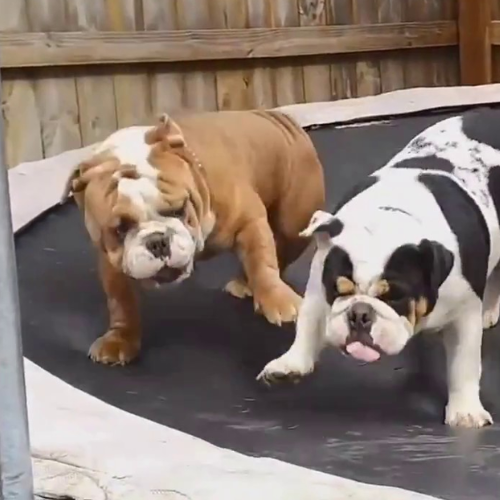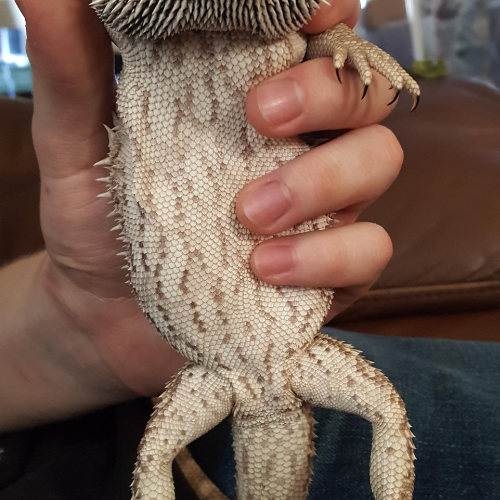The idea of installing a trampoline in the yard may sound like a fun activity for the children, but what about the dog? Will your dog enjoy this with the family? Trampolines offer amazing value and are enjoyable to use, so dog owners love them. But can dogs go on trampolines?
Yes, dogs may use trampolines, but as responsible dog owners, you must take steps to protect your lovely canine companion.

To ensure that both your dog and your trampoline remain safe, let’s go through a few different aspects of dogs using trampolines.
Puppy & Dog Safety Around Trampolines
Dogs, especially puppies, are more at risk when they use a trampoline. Usually, our children and dogs both will have fun together on the trampoline. So, during that time, children won’t pay any attention to the dog. So, it is possible that your dog could end up under your child and get bounced on (especially if your dog is a toy or small breed companion). So, teach your children how to use trampoline along with dogs and also monitor them all the time.
Are Trampolines Safe for Dogs?
The safety of trampolines for canines is a question that is asked frequently. There is no solution to this topic, but dog owners should be aware of the hazards.
Because dogs have the potential to tumble off trampolines when jumping or running on them, they should not be used around pets. Before letting your pet near a trampoline, ensure they know how to use it, especially if they’ve never jumped.
It’s also important for pet owners not to allow their dogs to jump on the trampoline unsupervised since this might result in severe injury or death from being strangled while jumping. Dogs should only be permitted on a trampoline when supervised by an adult.
Benefits of Trampolines for Dogs
If your dog is courageous enough, jumping on a trampoline for him might have benefits. The following are some of the benefits that come along with letting your dog bounce on the trampoline:
Stress Relieving Activity for Your Dog
To maintain their good health, dogs need to participate in some playtime. They are at risk of developing depression if they are not provided with any opportunities for physical activity. Trampolines are a great way to spend quality time and have fun with your dog.
Keeping Your Dog Fit
A dog will use nearly every muscle when jumping on the trampoline, which is a great exercise for them. Therefore, jumping on a trampoline is a very enjoyable exercise and an excellent workout.
If you’re busy, a dog sitter or family member can take your dog to the trampoline. This will keep your dog busy while you work. This way, your dog won’t miss an exercise.
Helps Burn Excess Energy
Many dogs are full of energy and might be difficult to handle. If you have a hyperactive dog, you’re always looking for methods to tire them out.
Dogs can be encouraged to burn off some excess energy by jumping about on trampolines, which can be purchased specifically for that purpose. This will save you time and make your dog happy. Trampolines let dogs expend calories without leaving the yard, like a walk.
Fun for the Dog
A dog jumps on a trampoline to have fun. The majority of dogs have a strong desire to participate in enjoyable activities, such as swimming in a pool or going for a run while playing fetch. It’s about appealing to their urge to have fun; a trampoline may help you achieve that.
A high-quality trampoline designed for canines will provide excellent value and make the dogs very happy. This benefit is why many dog owners are putting trampolines in their backyards.
Safety Precautions With Dogs and Trampolines
Now that you’re ready to have some fun with your canine companion, here are some safety precautions to keep you and your canine dog out of physical danger:
- Ensure that your dog is always under your supervision while they are around the trampoline.
- Before letting your dog jump on the trampoline, you should first train them by offering them rewards to learn the appropriate behavior.
- Dogs and children should not be allowed to jump on the trampoline simultaneously.
- Install a trampoline skirt to prevent your dog from running under it.
- You should continue to direct your dog and be close to them so that they feel secure.
- Don’t allow your dog to jump for too long on the trampoline. They will become worn out as a result, which is not good.
- There are fearless dogs who will try everything and scared ones that won’t. In this instance, they should obtain some basic trampoline training.
- If they have medical issues, they shouldn’t use the trampoline.
- Trampoline jumping is enjoyable and healthy, but it may be dangerous if you’re not careful.
Do Dogs Love Trampolines?
Some canines love trampolines. These dogs find unique methods to get on the trampoline and bounce. Most dogs find the trampoline surface strange and jump off.
How Do I Teach My Dog to Jump on the Trampoline?
Intelligent dogs may be taught to jump on a trampoline. When you first set up the trampoline, give them plenty of time to get used to jumping on it. The trampoline should not be viewed as a dangerous object by canines.
Get the toy your dog enjoys playing with the most, and then go on the trampoline with him or her. Let your dog get used to the trampoline’s surface by playing with it. This will teach your dog that the trampoline is a safe place to be.
What Are Dog Trampoline Beds?
The dog trampoline beds may look like little trampolines, but in reality, they differ from real trampolines in that they have no actual bounce.

Dog trampoline beds are just raised beds constructed of metal or wood, with a layer of soft material placed over the frame to offer your dog more flexibility. When your dog gets onto it, it should never bounce excessively or drop too low.
These raised beds give extra comfort to your dog while having a fun time. These beds come in various heights to accommodate all dog breeds according to their size and age.

Doctor of Veterinary Medicine (D.V.M.) at Nation Taiwan University,Master of Science (M.S.) in Biomedical Engineering at National Taiwan University of Science and Technology




